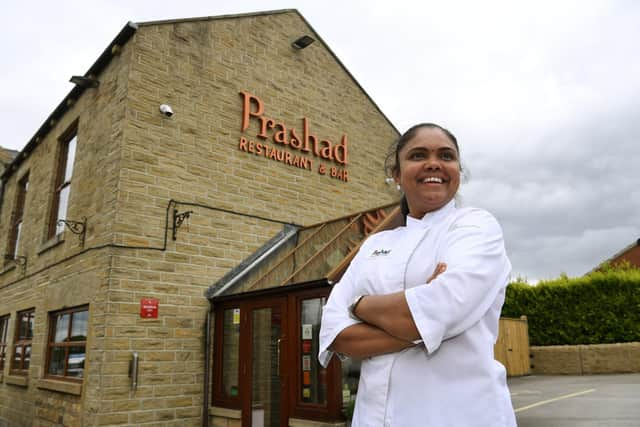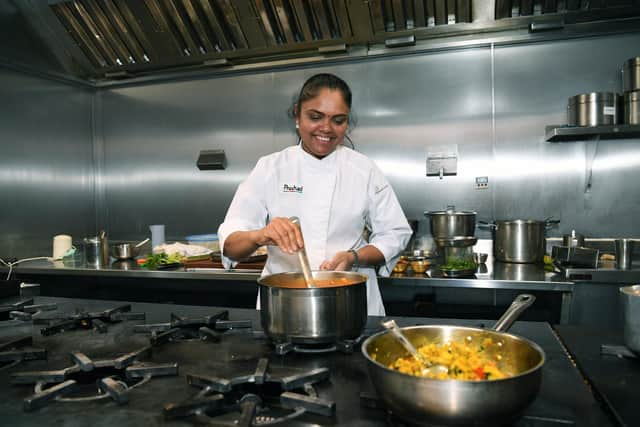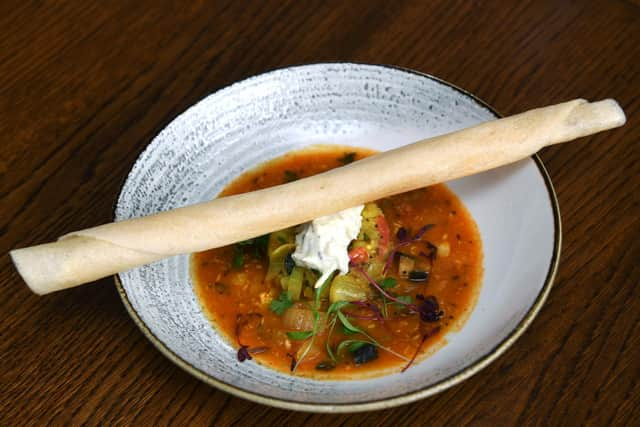Prashad Leeds: Meet the head chef behind the family-owned Indian restaurant in Drighlington
and live on Freeview channel 276
Kaushy and Mohan Patel began selling their Gujarati snacks and dishes to the local community, and the business grew from strength to strength.
Now located in Drighlington, Prashad boasts two AA rosettes and the Michelin Bib Gourmand award.
Advertisement
Hide AdAdvertisement
Hide AdAnd at the head of the kitchen is Minal Patel, the daughter-in-law of Kaushy and Mohan.


Minal grew up in Gujarat, India, before meeting her husband Bobby and moving to the UK.
“I learnt to cook with my mum," Minal, 40, told the Yorkshire Evening Post.
"We are vegetarian so we grew our own vegetables. And now I’ve brought that here, cooking the same authentic recipes in the restaurant."


Advertisement
Hide AdAdvertisement
Hide AdMinal was taken under the Prashad wing, learning the ropes from her parents-in-law before taking over the kitchen in 2004.
“I learn a lot from them," Minal said.
"I'd never experienced a restaurant kitchen before that. It’s different in India to how it is here - the treatment of the food, the equipment and recipes.
"I got nurtured by my father-in-law and he taught me the day-to-day of how the kitchen works.”


Minal has continued the Prashad legacy of authentic Gujarati food, while adding seasonal twists to the dishes using the best Yorkshire produce.
Advertisement
Hide AdAdvertisement
Hide AdShe has crafted a tasting menu where she can experiment with flavours - and it's been a hit with her customers.
Minal added: “We have a lot of focus on seasonal vegetables and local produce.
“I don’t change the menu fully because we have beautiful dishes on the menu that you can’t change.
"But when the new season comes, we tweak the menu with what's in season.
Advertisement
Hide AdAdvertisement
Hide Ad“My favourite dish on the tasting menu is a starter called Sakham Tikki, it's beautifully-flavoured with lots of herbs and spices.”
Everything on the Prashad menu is vegetarian, with plenty of vegan options, and the restaurant has been praised by critics for its vibrant and flavour-packed food.
“People who come to eat already have a high expectation of Prashad," Minal said.
"We have a lovely team and they deliver from the heart.
Advertisement
Hide AdAdvertisement
Hide Ad"We want to make our guests 100 per cent satisfied, so they tell people and come back again.
“Some people don’t know we’re vegetarian and when they come and eat, they’re blown away. They say they don’t miss the meat.
"That’s what we want to do.”
The support from customers saw Prashad through the pandemic.
Advertisement
Hide AdAdvertisement
Hide AdWhile the world shut down, Minal was busy in the kitchen preparing takeaway orders, and the restaurant's customer base grew as people looked to enjoy tasty food at home.
"I feel privileged and proud that people admire my food and my cooking," Minal said.
"I came from India and I learnt a lot, I studied here, and along the journey there are fantastic people with me who help to support me every day."
“This is my passion," she added.
"I love cooking and I love to go to Prashad. At 2pm every day, I’m ready to go to work. I’m very happy this is my family business.
Advertisement
Hide AdAdvertisement
Hide Ad“And we have lovely staff who are like family. They help me and support me so I never get tired.”
How to make Prashad's masala dosa
Minal has shared her recipe for Prashad's masala dosa, featured on her tasting menu.
The recipe, a crispy pancake served with potato and coconut curry, makes eight dosas - enough for four people.
Watch Minal's tutorial in the video above and follow along at home.
Step one - masala dosa
Batter (start at least 32 hours / 2 days before cooking)
Advertisement
Hide AdAdvertisement
Hide Ad275g broken rice; 65g urad dhal (white lentils); ½ tsp fenugreek seeds; warm water for soaking; 200-300ml cold water; 1½ tsp salt ; 1 tsp granulated sugar
Masala
3-5 fresh green chillies (ideally Kenyan), trimmed but not de-seeded; 4cm root ginger, peeled and roughly chopped; pinch of salt
Filling
100ml sunflower oil; 1 tsp cumin seeds; 1 tsp brown mustard seeds; ¼ tsp asafetida; 10 fresh curry leaves, washed; 2 medium onions, cut in 1cm cubes; 4 medium red-skinned (or other waxy) potatoes, cut in 2cm cubes; ¼ small fresh coconut, finely grated in long strands; 1 tsp salt; 1 tsp sugar; pinch of turmeric; 1 tsp garam masala; 1 handful fresh coriander, rinsed and finely chopped; sunflower oil for drizzling
Method
Mix the rice, dhal and fenugreek seeds together, then rinse three times in warm tap water, running your fingers gently through to help clean them (and to check for small stones), until the water runs clear. Put in a large bowl, pour in enough warm water to cover and leave to soak for 12 hours or overnight.
Advertisement
Hide AdAdvertisement
Hide AdDrain the soaked rice-dhal-seed mixture and grind in two batches in a food mixer or blender, along with 100ml of cold water with each batch to help the grinding. I tend to leave each batch blending for about five minutes. Don’t skimp this process as the more you grind it, the frothier the pulped mixture will become and the crispier the finished dosa will be.
Put the mixture in a large bowl and whisk thoroughly, then pour the batter in an airtight container. Place in a warn area for 24 hours while the batter ferments – this is what makes the dosa pancake so deliciously fluffy. (Don’t worry, I haven’t forgotten the salt, sugar and remaining water – they get added the next day, just before you cook the pancake batter!)
Crush the chillies and ginger together with a pinch of salt with a pestle and mortar (or in a blender) to make a fine masala paste.
Heat the oil in a large pan for a minute over a medium heat before adding the cumin seeds and mustard seeds. When the mustard seeds start to pop, add the asafetida and reduce the heat to low. Then stir in the curry leaves – be careful as they may spit when they touch the hot oil – followed by the onions and potatoes. Cook for a minute uncovered, stirring to coat the vegetables in the oil, then stir in the masala paste and all the other filling ingredients.
Advertisement
Hide AdAdvertisement
Hide AdIncrease the heat to high and cook for 3-4 minutes, stirring regularly. Reduce the heat to low, cover and cook for 10 minutes or so until the potato is cooked through, still stirring regularly to make sure that nothing is sticking or scorching. Remove from the heat and set aside.
Whisk the salt and sugar in to the fermented batter and check the texture – it should be pourable. If it seems stiff, stir in the remaining 100ml of cold water, then whisk again to get air back in to it.
Heat a non-stick frying pan over a low heat until a little water sprinkled on it immediately sizzles and bubbles away. Pour about 150ml of batter in the middle of the pan, then use a heatproof spatula, a palate knife or the back of a ladle to spread it over the surface of the pan, starting in the middle and working outwards in a circular motion.
Increase the heat to medium and drizzle a little oil around the edges. Fry the pancake for 1-2 minutes until the edges start to lift away from the pan. Then spoon an eighth of the filling in to the centre of the pancake. Lift the edges and fold over the filling so that you have a filled pancake roll. Use a spatula to turn it over to cook the other side (where the edges meet) for a minute, then lift out and place on a large plate.
Advertisement
Hide AdAdvertisement
Hide AdRepeat this process until you have four filled dosas. Serve each one with a bowl of hot sambar and a good spoonful or two of kopru dip on the side
Step two - sambar, aromatic vegetable and lentil soup
200g tuvar dhal (split pigeon peas/yellow lentils); 2 ltr boiling water;1 tsp sunflower oil; 400g tinned peeled plum tomatoes, finely chopped or blended; 1 baby aubergine, cut in 1cm cubes; 1 small-medium bottle gourd, peeled and cut in 1cm cubes; 4cm root ginger, peeled and roughly chopped; 30g fresh or frozen peas (ideally petits pois); 2½ tsp salt; 1 tsp turmeric; 1 tsp medium red chilli powder; 1 tbsp granulated sugar; ½ tsp garam masala; 1 handful fresh coriander, rinsed and finely chopped
Tarka (spiced oil): 50ml sunflower oil; 1 tsp cumin seeds; 1 tsp brown mustard seeds; ¼ tsp asafetida; 10 fresh curry leaves, washed
Method
Rinse the tuvar dhal at least four times in hot water, using your fingertips to rub the oily coating away and check for small stones, then leave to soak in hot water for 15 minutes before draining.
Advertisement
Hide AdAdvertisement
Hide AdPut the dhal in a large pan with 1.5 litres of boiling water (you can add one litre now and top up with the remainder while the dhal is cooking if your pan isn’t big enough to take 1.5 litres all at once). Bring to the boil then simmer over a medium heat for a couple of minutes until it starts to foam. Skim the froth from the surface, add the teaspoon of oil and simmer three-quarters covered for a further 28-30 minutes, stirring occasionally, until the dhal is cooked through (it should squash easily between your thumb and forefinger).
Add the tomatoes, bring the mixture back to the boil and simmer three-quarters covered again over a medium heat for 2-3 minutes, stirring every minute or so. Remove from the heat and blitz with a blender until the mixture has a really smooth texture.
Return the pan with the blended dhal-tomato mixture to a medium heat, stir in the aubergine and bottle gourd cubes along with the last 500ml of boiling water and leave to cook uncovered for 2-3 minutes. While it is cooking, crush the ginger with a pestle and mortar (or in a blender) to make a fine pulp.
Add the ginger, peas, salt, turmeric, chilli powder, sugar, garam masala and chopped coriander to the dhal mixture and stir through. Leave to simmer gently (uncovered) for 4-5 minutes while you prepare the tarka.
Advertisement
Hide AdAdvertisement
Hide AdHeat the sunflower oil in a small pan over a medium heat for about 30 seconds, then add the cumin seeds. When they start to darken (after about 30 seconds), tip in the mustard seeds, and as soon as they start to pop, add the asafetida. Add the curry leaves (be careful, as they will sizzle and spit), then slowly and carefully pour in a ladleful of the lentil-vegetable mixture, a little at a time – I do this at arm’s length as the hot tarka will spit. Stir through, then pour the contents of the small pan in to the large pan containing the rest of the lentil mixture and stir again.
Bring the sambar to the boil and simmer for 10-12 minutes partially covered over a low heat, stirring occasionally. Remove from the heat, cover and leave to rest for 15 minutes to allow the flavours to develop.
Reheat to boiling before serving, making sure that you stir well as some of the magic will be at the bottom of the pan. Any leftovers can be stored in an airtight container in the fridge for a couple of days, to be reheated with a little extra water and enjoyed as a speedy lunch or supper.
Step three - kopru, mustard seed, curry leaf and coconut dip
Advertisement
Hide AdAdvertisement
Hide Ad425g plain live set yoghurt; 70g coarse unsweetened desiccated coconut; ½ tsp salt; 2 tsp granulated sugar; 2 handfuls fresh coriander, rinsed and finely chopped; 2 fresh green chillies (ideally Kenyan), trimmed but not de-seeded; 75ml sunflower oil; 1 tsp brown mustard seeds; 1 tsp cumin seeds; 10 fresh curry leaves, washed
Method
Tip the yoghurt in a medium bowl and stir to break down to a smooth texture, then stir in the coconut, salt and sugar.
Blitz half the chopped coriander with the chillies in a blender to a medium coarse texture. Scoop in to the yoghurt mixture and stir through.
Heat the oil in a small pan for a minute over a medium heat before adding the mustard seeds and cumin seeds. When mustard seeds start to pop, add the curry leaves and the rest of the chopped coriander (be careful, as the leaves will sizzle and spit as they meet the oil) and stir through. Remove the pan from the heat.
Advertisement
Hide AdAdvertisement
Hide AdPour the spiced oil in to the yoghurt mixture and stir to combine. Cover with cling film and store in the refrigerator until you are ready to serve, so that it will be lovely and cold when you come to eat it.
